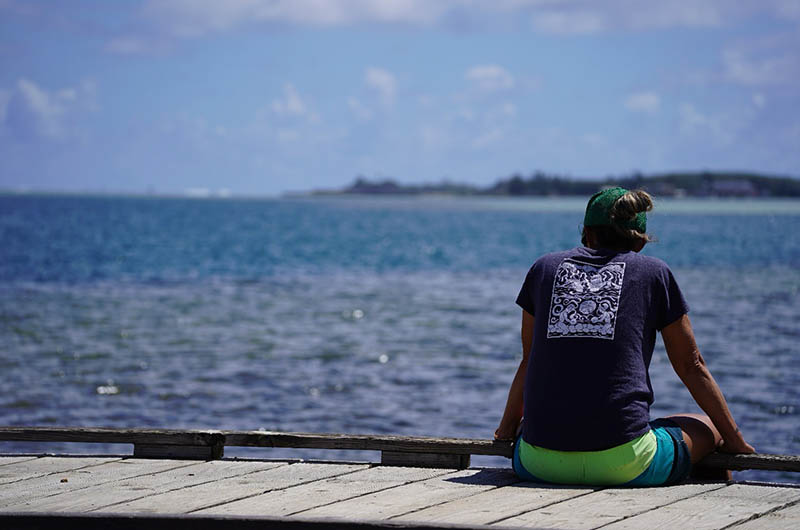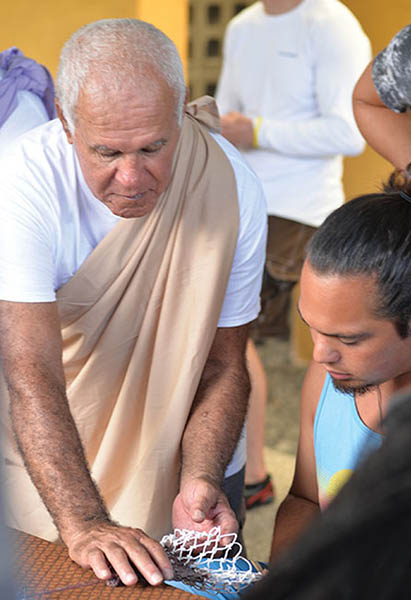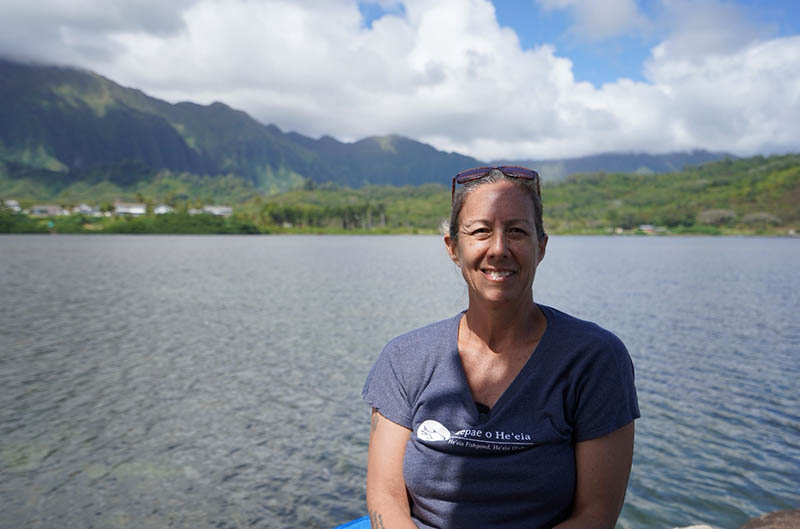10/14/24 – Kūpuna share biocultural knowledge through ‘Ike Kaiāulu video series
Our natural resources in Hawaiʻi are inextricably connected to the communities that rely upon and care for those resources. The “ʻIke Kaiāulu,” or “Community Knowledge,” video series seeks to tap into an understanding of this rich history of caring for ‘āina. The series premiered through the Division of Forestry and Wildlife in September of 2023 with four videos sharing community knowledge related to limu, wood carving, lāʻau lapaʻau, and caring for Kaʻena Point. Those videos can be found here.

Hiʻilei Kawelo sitting on the dock at Heʻeia Fishpond with her back to the camera.
In the second installment of the series, the Division of Aquatic Resources is rolling out three new videos. We spoke with Uncle Chuck Leslie, an ʻōpelu net-maker and fisherman; Hiʻilei Kawelo, the Executive Director of Pae Pae o Heʻeia which stewards the Heʻeia Fishpond; and Kawika Winter, Director of the Heʻeia National Estuarine Research Reserve.

Uncle Chuck Leslie passing on the skills of ʻōpelu net-making to the next generation.
The integral role of community in both land stewardship and knowledge sharing was a theme that spanned all three interviews. Uncle Chuck emphasized the importance of younger people learning the skills of ʻōpelu net-making to keep the craft alive, urging “If the young people don’t step up, it’s gonna get lost.” At the same time, he encouraged younger fishers to combine traditional knowledge and skills with what works for them, saying “They can even make it their own style.” His overall advice to young people: “Just do what they wanna do. If they wanna do fishing, make fishing their life and make it joyful. Make it joyful.”

Kawika Winter laughing during the interview at the Hawaiʻi Institute of Marine Biology.
Kawika Winter discussed the importance of community in scientific research. “We don’t do our scientific research out here in a way that’s separate from the community. We’re trying to interweave the work we do with the community. We position our research to help answer the questions that our community is asking.” He highlighted the unique positionality of Native Hawaiians caring for ʻāina. “We’ve been here for a long time, we’re gonna continue being here for a long time. And we’ve always eaten from this place and we want our future generations to always eat from this place. We have a vested interest in caring for this place, because if we didn’t care for it, it wouldn’t feed us. We take care of our islands and they take care of us.”

Hiʻilei Kawelo smiles at the camera in front of the Heʻeia Fishpond.
Hiʻilei Kawelo fondly spoke of community workdays at the loko iʻa, as well as her connection to the land in Kāne‘ohe Bay through her kūpuna. “This loko iʻa was built to feed community, so in our restoration efforts that’s been something that our organization has really tried to put forward… putting community first and involving community in the restoration and learning that comes from this loko iʻa. The relationships that we have within the ahupuaʻa—that’s what makes the magic happen.”
Kawelo and Winter also both spoke to moʻolelo having a guiding role in their work. “I love moʻolelo, because within those moʻolelo are lessons about how to properly care for and steward ʻāina. This loko iʻa and other loko iʻa – other fishponds – found throughout Hawaiʻi represent the intellect of our kūpuna, the ingenuity of our ancestors,” said Kawelo. Winter would agree, stating, “Moʻolelo are the foundation of our work. They help to inform the relationship of people to place, and they help us to inform the work that we do.”
You can find the newest ʻIke Kaiāulu videos here, in addition to DOFAW’s video on Uncle Wally Ito, the former Limu Hui Coordinator for Kua Ulu ʻĀina ʻAuamo.
This series has been primarily produced by DAR Communications Associate Claire Generous, Forestry and Wildlife Kupu Member Rachael Donnelly, and DAR Stanford Communications Intern Sam Howell Petersen, who wrote this piece.
